Offa and the Mercian Wars
Read Offa and the Mercian Wars Online
Authors: Chris Peers

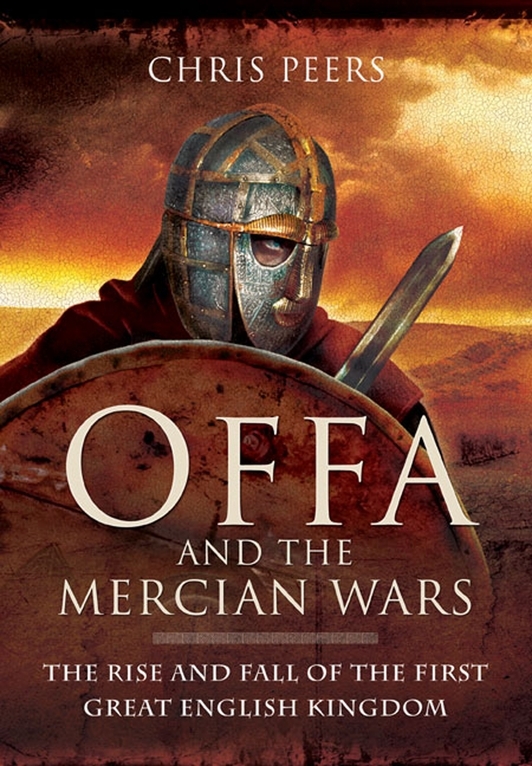
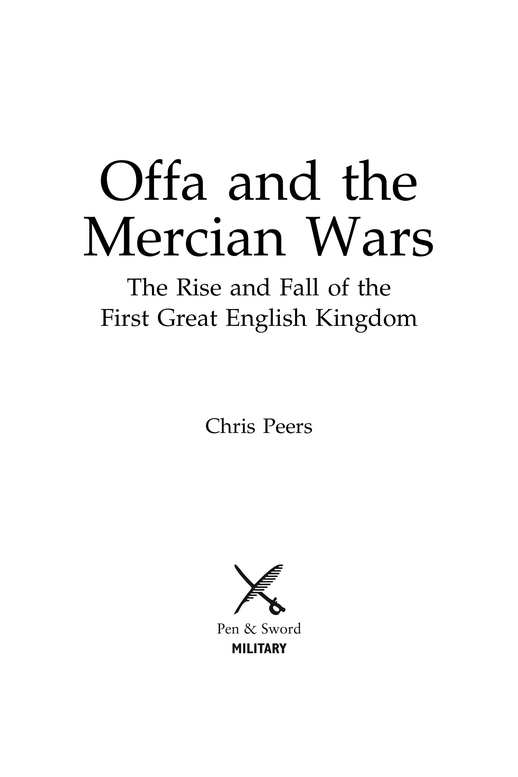
First published in Great Britain in 2012 by
Pen & Sword Military
an imprint of
Pen & Sword Books Ltd
47 Church Street
Barnsley
South Yorkshire
S70 2AS
Â
Copyright © Chris Peers 2012
9781781599921
Â
The right of Chris Peers to be identified as Author of this Work has been asserted by him in accordance with the Copyright, Designs and Patents Act 1988.
Â
A CIP catalogue record for this book is available from the British Library.
Â
All rights reserved. No part of this book may be reproduced or transmitted in any form or by any means, electronic or mechanical including photocopying, recording or by any information storage and retrieval system, without permission from the Publisher in writing.
Â
Typeset in 11/13.5 Palatino by Concept, Huddersfield, West Yorkshire
Â
Printed and bound in England by
CPI Group (UK) Ltd, Croydon, CRO 4YY
Â
Pen & Sword Books Ltd incorporates the Imprints of Pen & Sword Aviation, Pen & Sword Family History, Pen & Sword Maritime, Pen & Sword Military, Pen & Sword Discovery, Wharncliffe Local History, Wharncliffe True Crime, Wharncliffe Transport, Pen & Sword Select, Pen & Sword Military Classics, Leo Cooper, The Praetorian Press, Remember When, Seaforth Publishing and Frontline Publishing.
Â
For a complete list of Pen & Sword titles please contact
PEN & SWORD BOOKS LIMITED
47 Church Street, Barnsley, South Yorkshire, S70 2AS, England
E-mail: [email protected]
Website:
www.pen-and-sword.co.uk
Copyright Page
Prologue
Introduction
Rulers of Mercia, c. AD 600 â 874
Chapter 1
-
Offa's Country
Chapter 2
-
The People of the Frontier
Chapter 3
-
Kingdoms and Armies
Chapter 4
-
Penda's Wars
Chapter 5
-
Two Treasures
Chapter 6
-
Penda's Successors and the Rise of Offa
Chapter 7
-
The Warrior in the Age of the Mercian Kings
Chapter 8
-
âThe Glory of Britain'
Chapter 9
-
Offa's Successors and the Danish Invasions
Chapter 10
-
The âLiberation' and the Triumph of Wessex
Conclusion
Bibliography
Index
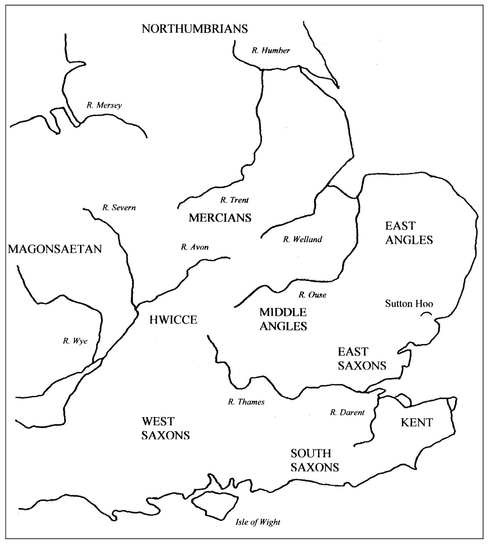
Map 1. The Mercians and their neighbours, c. AD 600.
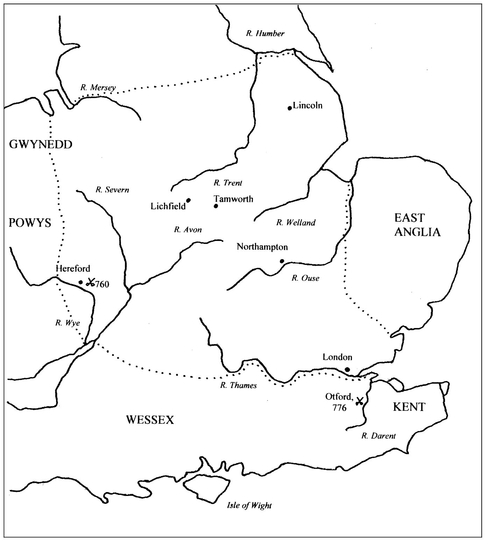
Map 2. Offa's kingdom, c. AD 790. The dotted line shows the approximate extent of Offa's direct rule. All of the named surrounding kingdoms recognised his overlordship at least temporarily.
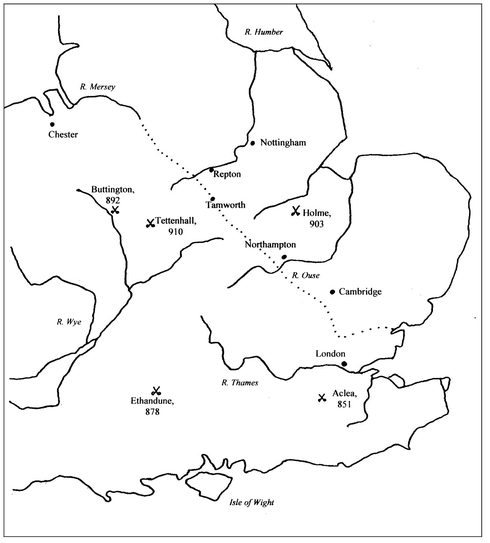
Map 3. The Viking Wars, c. AD 850 â 920. The dotted line indicates the approximate south-western boundary of Danish settlement.
Canterbury in the summer of 785 was a city not so much conquered by force of arms as stunned into submission. The ancient capital of the Anglo-Saxon kingdom of Kent, the seat of an archbishop, and a place which had already been Christian for almost two centuries, this was the most sophisticated settlement in England â one of the few places where those who could afford them had access to luxuries imported from the European mainland. From here emissaries went south to Rome and even Constantinople, and traders arrived from overseas with the products of exotic lands. But it was no longer in Canterbury that real power resided: a fact which was now being brought home to the inhabitants in the most uncompromising terms. The hundreds of dust-stained warriors who urged their weary horses through the streets on this ominous morning may have seemed strange and rustic to the men of Kent, but they were received in awestruck silence. They might have been mocked in secret as half-pagan savages, but their grim demeanour â and the reputation of the man who rode at their head â ensured that not a hand was raised in resistance. These were the Mercians from the heart of England, a wild frontier region famed as the school of warriors. Clad in coats of mail and iron helmets, bearing glittering spears and swords ornamented with the loot from countless victories, they were the mightiest army that England had yet seen. Their leader was the famous Offa, for nearly thirty years king of Mercia, and overlord of the neighbouring kingdoms as far as his raiding armies could reach. Now, at the height of his power, no one could be found to dispute his self-proclaimed title of âking of all England'.
Nine years previously the Mercians had met the men of Kent in battle at Otford on the River Darent, and after a day of dreadful slaughter on both sides Offa had retired, not defeated, but unable to obtain a victory decisive enough to secure his supply lines as he advanced further into hostile territory. Since then Kent had enjoyed a precarious independence under a local ruler named Ecgberht, but the shadow of the Mercian armies, though they were temporarily distracted on other frontiers, had never been entirely dispelled. Now Ecgberht was dead and Offa was here in his place, having led his elite mounted warriors on a ride of 200 miles from the Mercian heartland to surprise the men of Kent before their new ruler could raise an army, or even open negotiations. We have no eyewitness report of his arrival in Canterbury, but Notker's account of Offa's contemporary Charlemagne at Pavia in 773 may give us an idea of the impact the unexpected appearance of such an army could have. Rank after rank of horsemen advanced on Pavia, coalescing into a âbattle line of iron', in the centre of which rode Charlemagne, armoured in mail and holding aloft his sword. The defenders, we are told, panicked or fainted at the sight, the terrified citizens crying out in despair, âiron, iron everywhere!' Before the summer was out Offa would be holding court and issuing proclamations as if Kent was his by right, its ancient royal dynasty reduced to the status of vassals. So who was this man who, 1,000 years before Napoleon, could strike down kingdoms by his mere presence? Whence did he derive this power, and how did his successors lose it so completely that the name of Offa has been almost forgotten? This is the story of the Mercian kings, their victories and defeats, and the rise and fall of the first great English kingdom.
As taught in English schools for most of the last two centuries, and to a lesser extent still in the popular imagination, âEnglish history' begins, paradoxically, with the Norman Conquest of 1066. Apart from the Victorians' exaggerated admiration for empire builders such as the Normans, there are more understandable reasons for this disregard of the preceding centuries, an age which in reality saw the true creation of the English state. One reason is the scarcity of physical remains, for whereas places such as Greece, Italy and even southern France can show a more or less continuous sequence of buildings, aqueducts and other relics stretching from Roman times up to the present, in England there is very little to be seen from the period between the abandonment of the Roman villas at the end of the fourth century AD and the appearance of the first stone castles at the beginning of the twelfth. Documentary sources show a similar pattern, because English people of the fifth and sixth centuries were on the whole illiterate, and when their voice does start to be heard they are writing in a strange-looking language which at first glance bears little resemblance to the French-influenced English of the later Middle Ages. We do not even call them English: they are the âAnglo-Saxons', a name which emphasises their supposed alien origin, and the period in which they lived is popularly referred to as the âDark Ages', a label which almost removes it from history altogether into a world of myth and mystery, where any wild speculation or crank theory can flourish, and often does.
However, the country which the Normans conquered already had a long history. Domesday Book, compiled only twenty years after the conquest, describes a settled land of mostly prosperous villages, organised into shires and hundreds under a tight hierarchy of ownership, loyalty and obligation, their territories carefully arranged to provide each community with access to ploughland, pasture, woodland and other resources. The Normans did not create this arrangement. They owed it to the true owners of the land, whose efforts had brought it into the orbit of Roman Christianity after the chaos following the collapse of Roman secular power, and who had saved it from the Vikings, and turned it into probably the best governed and most productive kingdom in Europe. They had also produced some of the most celebrated artistic achievements of the early Middle Ages. Some of these, such as the illuminated Lindisfarne Gospels and the treasures of Sutton Hoo, have long been popular icons of Anglo-Saxon culture, but others are only now coming to light. In 2003 restoration work at Lichfield Cathedral in Staffordshire unearthed the âLichfield Angel', a magnificent eighth-century limestone sculpture now recognised to be of âEuropean importance' (âThe Lichfield Angel and the Saint Chad Gospels', booklet, Chapter of Lichfield Cathedral, 2005). And six years later, only a few miles outside Lichfield, the buried war gear of the âStaffordshire Hoard' emerged to challenge again our concept of the âDark Ages' with its exquisite decoration of gold and semiprecious stones. What is particularly interesting about these recent discoveries is their location in the English Midlands, in what was then the âforgotten kingdom' of Mercia. (The counties into which England was traditionally divided, incidentally, provide a useful guide to locating the places mentioned in this book, but they were not yet in existence in the Midlands in the time of the Mercian kings. They were introduced during the tenth century when the rulers of Wessex brought the area under their control after the Viking invasions.) For of the four main kingdoms into which Anglo-Saxon England was once divided, Mercia has always been regarded as the least interesting from a historical as well as a cultural point of view. Northumbria, whose heartland was along the north-east coast, had the great monasteries which produced the Lindisfarne Gospels and other symbols of the âNorthumbrian renaissance', as well as the influential historical work of Bede. East Anglia has the burial ground of its kings at Sutton Hoo, while Wessex, in the south, was the kingdom of Alfred the Great, the best-known pre-conquest English monarch, whose dynasty accomplished the defeat of the Vikings and the unification of the country in the tenth century.
However, as we are now coming to appreciate, Mercia was no backwater. In fact, in the seventh, eighth and early ninth centuries AD, before Wessex rose to its position of pre-eminence, it was the Mercian kings who dominated their neighbours and first earned the title of âkings of England'. Men such as Penda, Wulfhere, Aethelbald and the greatest of them all, Offa, whose name has always been associated with the famous âOffa's Dyke' along the Welsh border, and who received from a learned contemporary the description âthe glory of Britain'. Their rise was not a peaceful one, and battlefields across half of England, mostly now lost, were soaked in the blood of the Mercians and their enemies during their three centuries of glory. This book attempts to tell the story of how and why they achieved their victories and survived their defeats. Luckily the sources for this period are more extensive than they at first appear, and the last few decades have seen archaeologists and historians make dramatic progress towards putting it on a firmly historical footing. The most important narrative source for the early part of our period is Bede's A History of the English Church and People, which was written in Latin around the year 731. The âVenerable' Bede, as he has become known, was a monk who spent almost all his life in the monasteries at Jarrow and Monkwearmouth, in what was then the kingdom of Northumbria. He produced numerous erudite works, of which this history is by far the best known. As the title suggests, its primary concern is the conversion of the English to Christianity and the subsequent development of the church, but Bede also includes much information on political events and military campaigns, especially where these illuminate the careers of the early English saints. Despite the inclusion of miracle stories which the modern reader often finds difficult to take seriously, his book is a significant work of scholarship by the standards of the time, and he is often careful to identify his sources. Nevertheless his perspective is strongly pro-Northumbrian, and he is generally indifferent or even hostile to Mercia, which, for most of the century before he wrote, was Northumbria's traditional enemy. It is particularly unfortunate from our point of view that Bede died in 735 and did not live to record the career of Offa, although notes added to his manuscript after his death by an anonymous continuator do refer briefly to Offa's rise to power.
The other indispensable source is of course the Anglo-Saxon Chronicle â or rather Chronicles, because this compilation survives in several versions, written at different locations, whose relationship to one another is the subject of constant scholarly debate. Apart from the main chronicles associated with Winchester, Worcester, Abingdon, Peterborough and Canterbury, passages from what were apparently once independent works such as the Chronicle of Aethelweard, and the so-called Mercian Register covering the years 902 to 924, have been copied into some of the surviving versions. In order to avoid unnecessary confusion I have usually referred to all these sources as the Anglo-Saxon Chronicle. This is not unreasonable as they do follow each other very closely in most of the entries with which we are concerned, and they clearly derive from a common source. This source was probably first drawn up during the reign of King Alfred, was written in a West Saxon dialect of Old English, and mainly reflected the concerns of Alfred's own kingdom of Wessex. It was kept up to date more or less continuously from Alfred's time until the twelfth century. Like Bede, the Chronicle generally regards affairs in Mercia as of little consequence, and sometimes it displays a distinct political bias. But also like Bede, it is often the only source we have for the events it describes. The Chronicle gives a fairly detailed narrative of events from the end of the ninth century onwards, and is especially valuable for the Viking Wars of that period, but before that it seldom contains more than brief notices of the main events of each year. Many of these are evidently derived from Bede, and others apparently from notes inserted into tables produced by monks for the calculation of Easter. This source has often been used as evidence for the earliest period of Anglo-Saxon England, the supposed âinvasions' of the late fifth century, but here it is particularly unreliable, and its focus is almost exclusively on the West Saxons who were traditionally believed to have founded the kingdom of Wessex.
The Life of King Alfred written by the subject's chaplain, Asser, complements the Chronicle for the reign of its subject, but again is inevitably West Saxon in its outlook and concerns. Two other well-known works of early English literature belong to myth as much as to history, but they do provide us with an unrivalled picture of the âsharp end' of Anglo-Saxon warfare. The first is the epic poem Beowulf. This survives only in one late copy, but from internal evidence it has been deduced that it was first written down sometime in the century or so following the birth of Bede in 682 (Stenton). It is also thought that, although the present version is written in the West Saxon dialect, the original was composed in that part of the country which traditionally was settled not by Saxons but by Angles â probably, in other words, in Northumbria or Mercia. The poem may therefore be contemporary with the Mercian kings Aethelred, Aethelbald or Offa, or even have been composed at their courts. Its subject matter is not historical, but it powerfully evokes the world of the Anglo-Saxon warrior in the age of transition from paganism to Christianity. The other great English war poem recounts the exploits of Earl Byrhtnoth and his men at the Battle of Maldon in 991. Although dating from two centuries after the zenith of Mercian power, it describes weapons and tactics very similar to those which must have been used by Offa's armies, and presents a detailed account, if not of how a battle actually was fought, at least of how the noble classes believed it should have been. It is reproduced in full, in Old English and in translation, in Pollington (2001).
The notorious polemic entitled On the Ruin of Britain, written in the sixth century by a British monk named Gildas, is almost invariably the first point of reference for any study of early Anglo-Saxon England, but from our point of view it is of limited relevance and dubious reliability. The name of Nennius, a Welsh writer of the late eighth or ninth century, is traditionally attached to two more useful works which he may have edited rather than compiled personally: the Historia Brittonum or âHistory of the Britons', and the âWelsh Annals'. Nennius' stated intention was to reconstruct the history of the âBritons', or non-English inhabitants of the island, which had been shamefully neglected by their own scholars. He remarks ruefully that their failure to keep proper records has forced him to rely heavily on English sources, so he can hardly be regarded as an independent source himself. However, he does provide some useful additional information, mainly from a Welsh perspective. Nennius is better known nowadays as the first historian to describe the career of the legendary King Arthur. A selection of early Welsh poems, notably the eulogies for Cadwallon and Cynddylan, two of Mercia's allies, shed a further faint light on affairs in central England in the lifetimes of their heroes.
I have also been unable to resist some of the contributions made by Henry of Huntingdon, whose History of the English People was written at Lincoln early in the twelfth century. Henry seems to have consciously intended to bring Bede up to date, and obviously relied on him for much of his early material. However, he does include additional details, especially in his battle accounts, which are written in his characteristically lively and entertaining style. Some of these accounts probably derive from his own imagination, but others contain hints that they might preserve material from other sources now lost, the âchronicles preserved in ancient libraries' which the Bishop of Lincoln advised him to consult. Another reason for not disregarding Henry is his location in the East Midlands, which put him in a better position than either Bede or the West Saxon annalists for recording oral traditions relevant to Mercian history. Several other writers of the post-Norman Conquest period dealt with the early Anglo-Saxons, and may, like Henry, have had independent sources to which we no longer have access. They include Simeon of Durham, Florence of Worcester, Roger of Wendover, William of Malmesbury, Matthew Paris, and the author of the fourteenth-century Flowers of History; the latter is traditionally ascribed to Matthew of Westminster and I have retained this attribution here, even though Matthew himself is now believed by many to be a fictional character.
Many writers on the subject of Anglo-Saxon warfare have relied heavily on analogy with Scandinavian sources, especially the Viking sagas. This is understandable because of the shortage of detailed accounts of English battles, and because the Scandinavian material does seem to come from a very similar warrior culture to that described in Beowulf, for example. Weapons were almost identical, and it is logical to assume that so were the methods of using them. However, while acknowledging that these sources can sometimes shed light on our subject, I have tried not to lean too heavily on them. They are, after all, at two removes from the world of the Mercian kings, having been written down in distant lands several centuries after the events they purport to describe.
Other sources which can illuminate the Mercian Wars in passing include the published laws of several Anglo-Saxon kings (none of them, unfortunately, Mercian), and the biographies of saints, not all of whom led entirely peaceful lives. Reference will also be made to the surviving âcharters' of the period from the eighth century onwards, which record grants of land made by kings and others in authority, often to ecclesiastical houses. These rather dry documents are of interest for two main reasons. Firstly, they record the names and often the titles of the parties, and so can show where a certain person was at a particular time and how he wished to style himself. The location of Offa's âpalace' at Tamworth, for example, is deduced not from a specific statement in the narrative sources but from the frequency with which he issued charters from that town. Similarly, documents in which Offa grants land in other kingdoms, such as Kent, provide us with a guide to the extent of his power as well as hinting at his presence on military campaigns. Many charters also define the extent of the territory they grant by describing a perambulation of its boundaries, and these have enabled scholars to reconstruct the appearance of the countryside and the frequency of woods, roads and other features.